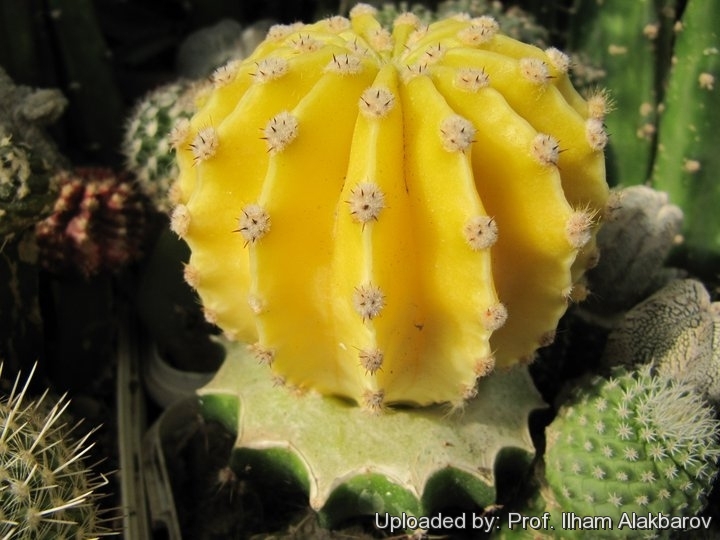Accepted Scientific Name: Echinopsis eyriesii (Turpin) Pfeiff. & Otto
Abbild. Beschr. Cact. i. sub t. 4.1839 Pfeiff.

Echinopsis eyriesii f. aurata Photo by: Prof. Ilham Alakbarov
Origin and Habitat: Garden origin. The natural species is native to Southern Brazil, Uruguay, and province of Entre Rios, Argentina.
Synonyms:
See all synonyms of Echinopsis eyriesii
back
Accepted name in llifle Database:Echinopsis eyriesii (Turpin) Pfeiff. & OttoAbbild. Beschr. Cact. i. sub t. 4.1839Synonymy: 35
back
Description: Echinopsis eyriesiiSN|17377]]SN|8004]] is a very popular large caespitose cactus, widely grown for the huge nocturnal flowers. It is the best known and most commonly grown globular cactus. In time it may exceptionally forms large mounds.
Forma aurea or aurata (Yellow form): The schizochromic form (Parodia magnificaSN|20453]]SN|20453]] f. aurata) has pale yellow stems due to the absence (or reduced production) of chlorophyll pigments: every other pigment is present at normal levels, the dominant green colouration is lost, but will still more than likely have normal other pigments that give the yellow overall appearance of the stem. This plant with yellow stems is very attractive and highly prized. IT is almost always seen grafted on stronger columnar species, and cannot can be grown on its own roots. However some clones have enough chlorophyll in their tissues and can be grown on they own roots too, but very slow growing.
Stem: Yellow, globular, later elongated and almost cylindrical, 15-30 cm high, 12 to 15 cm thick, and heavily ribbed.
Ribs: 9 to 18, not tuberculate, prominent, rather thin above.
Areoles: Circular, filled with white or tawny wool up to 1 cm apart.
Spines: Several, 14 to 18, very short.
Radial spines: Thin 5-10 mm long often missing in adult specimens.
Central spines: 4-8 thick, conical, less than 5 mm tall, hard, blackish. Young plants and offshoot initially have longer and weaker spines, the stout short conical spines appear only later.
Flower: Nocturnal, pure white, very large, from the side of plant but above the middle, 17 to 25 cm long, 5-10 cm in diameter (The presence of pink shades in the flower shows hybridization). Floral tube funnel-shaped with a strong basal part underlying the ovary, then narrow and variously curved and gradually extending into the crown, dark green covered with small, ovate, brownish scales and dark grey to black hair. Lower outer perianth segments, rather linear and greenish, inner perianth-segments broad and white, acuminate. Throat greenish, with several several stamens around the inner perimeter. Stamens and style shorter than the perianth-segments. Flowers are intensely fragrant.
Blooming season: Flowers appears from spring to summer in several flush at night. In sunny weather the next day they fade, but in cold, rainy weather they may last two, rarely three days.
Fruit: Up to 5 cm long, green, covered with hairs and containing a large number of black seeds.
Remarks: Echinopsis eyriesiiSN|8004]]SN|8004]] is strictly related and forms a complex with Echinopsis oxygonaSN|8380]]SN|8376]], Echinopsis multiflora and Echinopsis multiplexSN|8376]]SN|8380]] (and their hybrids). All this species have the same elongated stem with sharp ribs and long funnel shaped flowers, but distinguish for the longer spines and the pink flowers usually unscented. Sometime Echinopsis eyriesiiSN|8004]]SN|8004]] is confused with Echinopsis subdenudataSN|8004]]SN|17377]] that has round (not elongated) stems with very large woolly areoles.
Subspecies, varieties, forms and cultivars of plants belonging to the Echinopsis eyriesii group
Bibliography: Major references and further lectures
1) Edward Anderson “The Cactus family” Timber Press, Incorporated, 2001
2) James Cullen, Sabina G. Knees, H. Suzanne Cubey "The European Garden Flora Flowering Plants: A Manual for the Identification of Plants Cultivated in Europe, Both Out-of-Doors and Under Glass" Cambridge University Press, 11/Aug/2011
3) David R Hunt; Nigel P Taylor; Graham Charles; International Cactaceae Systematics Group. "The New Cactus Lexicon" dh books, 2006
4) N. L. Britton, J. N. Rose “The Cactaceae. Descriptions and Illustrations of Plants of the Cactus Family.” Volume 4, The Carnegie Institution of Washington, Washington 1923
5) Curt Backeberg “Die Cactaceae: Handbuch der Kakteenkunde” Gustav Fischer Verlag, Stuttgart New York 1982–1985
6) John Borg “Cacti: a gardener's handbook for their identification and cultivation” Blandford P., 1970
7) Arthur Gibson, Park Nobel “The cactus primer” Harvard University Press, 01/Oct/1990
8) Hecht, “BLV Handbuch der Kakteen” BLV Verlagsgesellschaft mbH, München
9) Erik Haustein “Der Kosmos-Kakteenführer” Balogh Scientific Books 1998
Cultivation and Propagation: Variegated and albinous cacti are regarded as choice and difficult in cultivation, but despite that many of them are relatively easy to grow. But be aware that they cannot tolerate prolonged exposure to direct sun light (especially during the hottest summer days), so grow them in half-shade or under filtered sun. They are sometime seen as grafted plants, but many grow well on their own roots, too.
On the contrary, the albinos can survive only if grafted on a strong green base.
Use mineral well-permeable substratum with little organic matter (peat, humus). Water sparingly from March till October and keep perfectly dry in winter at temperatures from 5 to 15 degrees centigrade. (In general these plants are more tender and cannot endure freezing temperatures ) In the rest period no high atmospheric humidity!!
Propagation: Plants are often grafted onto column-shaped cacti.










